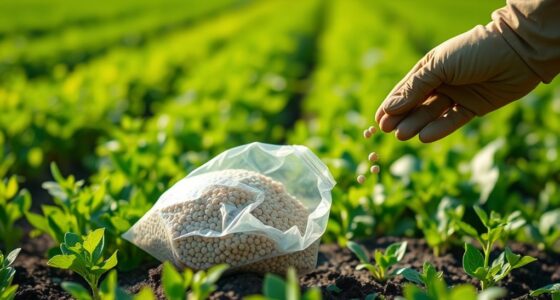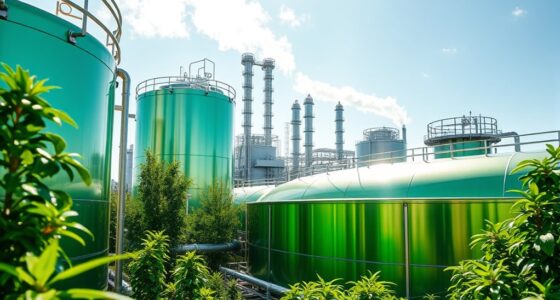Nitrogen cycling in soils involves microbes converting atmospheric nitrogen into forms plants can use through processes like fixation, nitrification, and denitrification. You’ll find bacteria like Rhizobium fixing nitrogen into ammonia, which is then oxidized into nitrite and nitrate by Nitrosomonas and Nitrobacter. Denitrifying bacteria return nitrates back to the atmosphere, completing the cycle. Understanding these processes helps you manage soil health better—stay tuned to discover more about how these essential transformations work.
Key Takeaways
- Nitrification converts ammonia to nitrite and then to nitrate, making nitrogen accessible for plant uptake.
- Denitrification reduces nitrates back to atmospheric N₂ or N₂O, completing the nitrogen cycle.
- Microorganisms like Nitrosomonas and Nitrobacter drive nitrification, while Pseudomonas and Clostridium facilitate denitrification.
- Soil conditions such as pH, moisture, and organic matter influence the efficiency of nitrogen transformations.
- Understanding these processes helps optimize soil fertility and manage nitrogen loss in agriculture.

Have you ever wondered how nitrogen moves through soils and supports plant life? It’s a fascinating process that involves several biological and chemical steps. One key aspect is nitrogen fixation, where specialized bacteria convert atmospheric nitrogen (N₂) into forms plants can absorb, like ammonia. This process often begins with ammonia fixation, a type of nitrogen fixation where bacteria such as Rhizobium or free-living soil microbes take atmospheric nitrogen and transform it into ammonia through enzymatic reactions. This ammonia then becomes a crucial nutrient for plants, fueling their growth and development. Microbial activity driven by nitrogen fixation is essential for maintaining soil fertility and ecosystem health. Once ammonia is produced, it doesn’t stay in that form for long. Soil microbes quickly act on it, turning it into other forms through nitrification. During nitrification, ammonia is first converted into nitrite (NO₂⁻) by bacteria like Nitrosomonas. Then, another group of bacteria, such as Nitrobacter, oxidizes nitrite into nitrate (NO₃⁻). This nitrate form is highly soluble and readily absorbed by plant roots, making it essential for healthy plant growth. The entire process of ammonia fixation and subsequent nitrification ensures that nitrogen, initially inert in the atmosphere, becomes accessible and usable within the soil ecosystem.
However, the nitrogen cycle doesn’t end there. When plants take up nitrates and other nitrogen compounds, some of that nitrogen returns to the soil after plant decay or through excretion. Microorganisms continue to play a role, especially in denitrification, where bacteria like Pseudomonas and Clostridium convert nitrates back into atmospheric nitrogen (N₂) or nitrous oxide (N₂O). This step completes the cycle, returning nitrogen to the air and maintaining a balance in the soil’s nitrogen content.
Understanding these processes reveals how dynamic and interconnected the nitrogen cycle truly is. Your soil’s health depends on the activity of microbes that perform ammonia fixation and other nitrogen transformations. Factors like soil pH, moisture, and organic matter influence these microbial actions, impacting nutrient availability for plants. When conditions favor efficient nitrogen fixation and nitrification, plants thrive with ample nitrogen. Conversely, if denitrification becomes dominant, it can lead to nitrogen loss from the soil, reducing fertility. Recognizing these pathways helps you manage soils better, ensuring plants receive the nitrogen they need to grow strong and healthy.
Frequently Asked Questions
How Do Soil Ph Levels Influence Nitrification Rates?
You’ll notice that soil pH levels greatly impact nitrification rates through soil acidity, which influences microbial activity. When the soil is too acidic (low pH), microbial activity slows down, reducing nitrification. Conversely, neutral to slightly alkaline soils promote ideal microbial activity, boosting nitrification rates. Maintaining appropriate soil pH ensures microbes effectively convert ammonium to nitrate, supporting healthy plant growth and efficient nitrogen cycling in your soil.
What Role Do Plants Play in Nitrogen Fixation?
You might think only scientists understand nitrogen fixation, but plants are key players too. Leguminous plants, like beans and peas, team up with symbiotic bacteria in their roots to convert atmospheric nitrogen into forms the plant can use. This natural process enriches soil fertility, reducing the need for synthetic fertilizers. So, your garden’s healthier and more sustainable when these plants and bacteria work together to fix nitrogen.
Can Nitrification and Denitrification Occur Simultaneously?
Yes, nitrification and denitrification can occur simultaneously, especially in soils with uneven microbial interactions and varying soil aeration. When soil has pockets of low aeration, denitrification becomes more active, converting nitrates into nitrogen gases. Meanwhile, in well-aerated zones, nitrification converts ammonia into nitrates. Both processes often overlap, creating a dynamic nitrogen cycle driven by microbial interactions and soil conditions.
How Does Soil Moisture Affect Nitrogen Cycling Processes?
Soil moisture critically influences nitrogen cycling, affecting soil aeration and microbial diversity. When soil is too wet, aeration decreases, favoring denitrification, which converts nitrates into gases. Conversely, well-drained soils with ideal moisture levels promote nitrification by supporting diverse nitrifying microbes. Maintaining balanced soil moisture ensures active microbial diversity, facilitating efficient nitrogen transformation processes and preventing nutrient losses or imbalances in your soil system.
What Are the Environmental Impacts of Excess Nitrogen in Soils?
When excess nitrogen hits your soil, it’s like opening Pandora’s box—causing environmental issues. You might see nitrogen pollution leach into waterways, harming aquatic life, or trigger soil acidification, which weakens plant roots. Over time, this imbalance can lead to reduced soil fertility and increased greenhouse gases. You need to manage nitrogen wisely to prevent these problems from snowballing, protecting both your land and the environment.
Conclusion
Understanding nitrification and denitrification helps you grasp how nitrogen moves through soils. It allows you to see how bacteria transform nitrogen, how gases escape, and how plants absorb nutrients. By recognizing these processes, you can better manage soil health, reduce pollution, and support sustainable agriculture. Embrace this knowledge to protect ecosystems, improve crop yields, and contribute to environmental balance. In understanding nitrogen cycling, you empower yourself to make informed decisions for a healthier planet.









